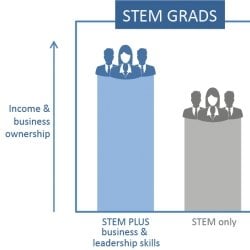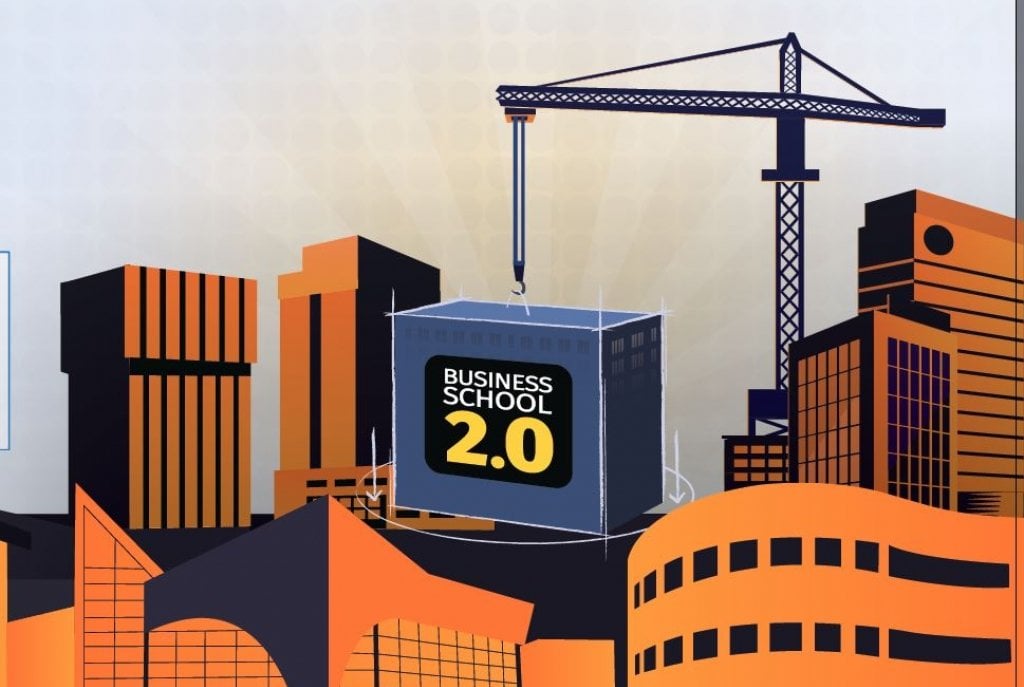It's time to propel our high-quality, high-tech identity.
It's Time.
Building into the Next Century.
After more than a century of service to students, faculty, and alumni, the oldest business school building in Michigan is bursting at the seams. Everything is at capacity-from the LSGI Trading Room to comfortable places for a student/advisor exchange. The need for more space is at critical mass.
Alumni and faculty know the challenges of the current building. We have seen creative thinking and space conservation excel to the point where closet space is a valuable commodity. Now is the time to give the school the space it needs to advance. Now is the time to look forward to accelerating the skills of business school students and STEM engineering students alike. Now is the time to clearly say "the good old business school building" just won't get us there.

Advance students to management and business ownership
Most STEM grads who reach high income brackets do so because they move into corporate leadership positions or start their own businesses. Business, communication, and leadership skills are the core strength of the SBE. Business School 2.0 will become a magnet for students who see their careers (and income) as continuously expanding.

"A new building can't come soon enough. Our student organizations are outgrowing our space! We need room to expand our hands-on student learning centers."

"Our students are hard-working and smart. They deserve a place they can call home."

"We have so many incredible things going on! We need a place where managing the additional student services is progressive and effective."
Dynamic Impact At Every Level
A few times in the lifetime of an organization there is a golden opportunity for sweeping,
positive change. It may come in the form of an unexpectedly generous bequest or new
leadership. And sometimes it takes the shape of bricks, mortar, and leading-edge equipment
and technology. Michigan Tech’s School of Business and Economics is on track to undergo
a significant leap forward as it closes in on its goal to raise funds for a new state-of-the-art
building that will house classrooms, labs, meeting spaces, and offices.
Dean Johnson, Dean of Michigan Tech’s School of Business and Economics, is ready.
He notes, “We’re planning dynamic impact at every level.” Johnson is not the first
dean to have “new building” at the top of their wish list, but his call to action
is likely to succeed. Thanks to one million in seed money, courtesy of class of 1970
alumni Richard and Joyce Ten Haken (story on page 22), the SBE has taken a huge leap
forward on its long-long awaited path to a new building.
Dean Johnson is grateful…and ready. “The Ten Hakens loved their SBE education,” says
Johnson. “They tell us they received much better preparation for their careers than
graduates of other schools, and they want to show their gratitude by helping to provide
an identity for the school on campus. It can’t come soon enough...we need a stronger
presence. This is a very exciting time for the school.”
The existing School of Business and Economics structure enjoys a few impressive, 21st-century
upgrades, like a graduate lab space and the LSGI Trading Room, which houses the award-winning
Applied Portfolio Management Program. The current building’s turn-of-the-century charms
are obvious to anyone walking through the massive wooden front doors. But terrazzo
steps and a Doric portico do not make up for the absence of modern educational resources.
The 110-year-old Academic Office Building has one classroom established through creativity
and collaboration with the Social Sciences Department, necessary to teach evening
MBA courses. Faculty offices are cramped, freezing in winter, sizzling in summer.
Space for student groups has been cobbled together from storage closets. The building’s
shortcomings are starting to reach critical mass. Despite such barriers, the School
continues to offer exceptional programming, due to faculty and staff dedication and
to the resourcefulness of the students who come in after hours to use space that during
the day is occupied by faculty and staff. Like the Ten Hakens, they still get an excellent
education, but they shouldn’t have to work in shifts, says Johnson. “Our students
deserve more than this.”
A reflections of talent
Johnson states, “Our vision is to be the premier, tech-infused, experiential business
educator in the Upper Midwest. In many ways, we are perfectly situated for that. We
have great students and faculty, and our alumni are very successful. We are part of
a top-notch technological university. We’d like a building that matches the caliber
of our talent.”
Johnson’s vision incorporates both academic departments and student organizations.
A new building would house the School’s “Spires of Excellence” within all academic
programs. The Spires will showcase cutting edge technology used by students and hands-on
learning necessary for preparation to manage the business world’s ever changing demands.
For example, one might see accounting students using big data and date visualization,
MIS students keeping abreast of trends in cybersecurity and Excel in a laboratory
with computing hardware supplies, and marketing students learning in a state-of-the-art
research space. A dedicated space will allow for additional high tech classrooms,
which will help alleviate the current scheduling challenges due to insufficient space.
The new building will allow students in engineering management, SBE’s fastest growing
major, a space to work together on the many group projects. And it will provide MIS
students with a proper lab. Johnson notes, “The MIS Advisory Board wants to build
a new student cybersecurity lab, so MIS majors can have a network that’s independent
of the University network. A new building would provide enough space for that.” It
will also give SBE faculty a home base, so they will not have to travel all over campus
to teach, and provide more comfortable, private office space for student consultations
with faculty and advisors alike.
The building will also provide a home for the growing list of student organizations
and services with locations to hold meetings, conduct business and host community-based
programs. Johnson says, “We need to provide good space for our students’ hands-on
application, like the American Society for Marketing Research to meet with clients,
as well as Volunteer Income Tax Assistance (VITA) program to provide income tax services
to campus and the community annually. Even a committed space for expanded tutoring
services.”
Higher salaries: the SBE/STEM connection
It’s not just business students who would benefit from a new facility. At Michigan Tech, the School of Business and Economics compliments the STEM disciplines. A new building will allow the SBE to fully realize that partnership. “We have a dual mandate,” says Johnson. “One, to produce business students with an affinity for technology. Our second mandate, is to be a bridge for STEM students to learn business skills.”
It is beneficial for students to get dual degrees in business and engineering, especially
since it often takes five years to earn an engineering bachelor’s degree anyway. Students
who follow that path have been quite successful, Johnson explains, “because they have
business, communicate, and teamwork skills.”
“The engineering graduate doesn’t realize that in five years, they will need business
skills to advance, and by then it may be too late,” says Johnson. “Our hypothesis
is that we are producing excellent engineers at Michigan Tech, some whom may not have
the skills to transition to upper level corporate positions. We want to help prepare
them by providing a foundation of necessary business knowledge for promotion. SBE
also helps students by building a strong set of soft skills and leadership necessary
for career advancement. STEM students graduating with a connection to SBE will leverage
higher entry-level earning potential.”
To help bridge the gap, SBE is adding a minor in business as a pathway for students to prepare for advancement along with a recently revamped Tech MBA® tailored for Tech grads. Johnson explains, “a business minor will give STEM students an introduction to business. And the Tech MBA® adds critical management skills to STEM students’ already incredible set of technical skills. This kind of service to non-business majors is key for students’ future success.” Johnson thinks the new building’s location should take that into account by providing sufficient space for the SBE faculty and all Michigan Tech students to work together.
Those in the STEM disciplines have a lot to gain from closer ties with the school of business, says former Michigan Tech President Glenn Mroz. “People with technical backgrounds have always commercialized their research, but that trend is accelerating,” he said. “The School needs dedicated space to support collaboration between SBE and entrepreneurs from the STEM disciplines.”
Increasing capacity and presence
A new building is essential for establishing that rapport with the rest of campus,
says Johnson. “The School of Business and Economics is not a silo, and we never have
been, but our location does isolate us,” he says. “We’re looking forward to increasing
our visibility on campus. We need—the entire University needs—more and better space
to
house interaction between us and the student body, especially Enterprises and Entrepreneurs
Club: they aim to elevate entrepreneurship.”
The successful integration of STEM and business is illustrated by the School’s dynamic IT Oxygen Enterprise. “Campus is moving from pure STEM toward commercializing skills and ideas,” says Jodie Filpus-Paakola, SBE’s coordinator of academic services. “Even the SBE led Enterprise doesn’t just have business students. We have majors in computer science, technology, and computer engineering. They won’t end up with a business degree, but they will learn a lot about running a business.”
The University as a whole will benefit from a modern new facility. It will open the door to growing the graduate program and allow the SBE to double enrollment, including distance learning. Johnson says, “Having dynamic classrooms with recording capabilities, smart boards, and real-time connections with faculty through distance and face-to-face students, will elevate the profile of the school as a national leader alongside the University. The addition of quality labs and centers of excellence may even expand corporate engagement opportunities. Johnson notes, “For years, our mantra has been, ‘Invest in people,’ and we’ve done that. But in the end, to attract faculty and students, you need to invest in infrastructure. They need a good place to work and learn.” Filpus-Paakola agrees: “The time for partial measures is over,” she says. “No more Band-Aids.”
Accounting professor Joel Touriniemi, is also excited by the prospect of a new, state-of the-art signature facility with all the amenities of Michigan Tech’s peer institutions. “Our students are outstanding. They deserve a place they can call home.”
Business School Students
- A modern home for the School that brands every student with a memorable identity for their career paths
- Dedicated high-tech classrooms and learning areas to maximize student/faculty interaction
- Space expansion for hands-on programs such as Applied Portfolio Management, IT Oxygen Enterprise, and Marketing Lab to flourish
STEM Students
- Expanded access for STEM students to acquire the skill-sets they need to accelerate to corporate leadership positions and higher salaries later in their careers
- A highly visible and attractive magnet for STEM students to acquire both a minor in business and an accelerated Tech MBA®
- A center for advisors to consult STEM students who want to elevate their business savvy
Faculty and Advisors
- Faculty can stay grounded in one location versus going all over campus to teach classes
- More comfortable, private office settings for teaching and advising
- Elevate the spires of excellence for each academic program
- Improve efficiency and effectiveness in the student experience
- Higher profile image to elevate the School as a premier provider of technology infused business
Campus and Alumni
- Home for multi-disciplinary experiences such as Enterprises for STEM and Business students to collaborate
- Potential to double enrollment
- Maximize future corporate engagement and enterprise opportunities
- Facilitate exposure to business and its benefits for STEM students
A view toward the future:
The School of Business and Economics gets the dedicated dynamic space it deserves in order to support our students, faculty and alumni.
Accelerate and enhance our programs of Accounting, Economics, Engineering Management, Finance, Management (with concentrations in Entrepreneurship or Supply Chain and Operations Management), Management Information Systems, and Marketing.
Michigan Technological University is an R1 public research university founded in 1885 in Houghton, and is home to nearly 7,500 students from more than 60 countries around the world. Consistently ranked among the best universities in the country for return on investment, Michigan's flagship technological university offers more than 185 undergraduate and graduate degree programs in science and technology, engineering, computing, forestry, business, health professions, humanities, mathematics, social sciences, and the arts. The rural campus is situated just miles from Lake Superior in Michigan's Upper Peninsula, offering year-round opportunities for outdoor adventure.





